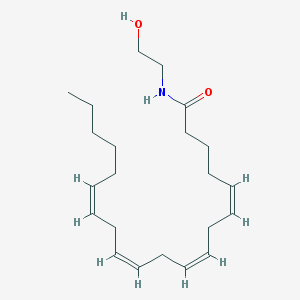Anandamide (AEA)

Molecular Formula: C23H38O4
Image credit: PubChem
Anandamide (also known as N-arachidonoylethanolamine)
(AEA) is a neurotransmitter that is produced naturally by the human body (endogenous).
Anandamide is a ligand that interacts with the cannabinoid receptors, CB1 and CB2.
Isolation and structure of a brain constituent that binds to the cannabinoid receptor.
Devane WA, Hanus L, Breuer A, Pertwee RG, Stevenson LA, Griffin G, Gibson D, Mandelbaum A, Etinger A, Mechoulam R.
Science. 1992 Dec 18;258(5090):1946-9.
PMID: 1470919
It was termed Anandamide based on the Sanskrit word “Ānanda” meaning “eternal bliss”.
The Anandaminde Metabolism Pathway is explained in closer detail in the National Cancer Institute Thesaurus.
Ānanda turned out to be a prescient inspiration, because it has since been found that Anandamide plasma levels are significantly reduced in patients with major depression,
Circulating endocannabinoids and N-acyl ethanolamines are differentially regulated in major depression and following exposure to social stress.
Hill MN, Miller GE, Carrier EJ, Gorzalka BB, Hillard CJ.
Psychoneuroendocrinology. 2009 Sep;34(8):1257-62. doi: 10.1016/j.psyneuen.2009.03.013. Epub 2009 Apr 25.
PMID: 19394765 and the blocking of Anandamide hydrolysis exerts robust anti-depressant-like effects.
Antidepressant-like activity and modulation of brain monoaminergic transmission by blockade of anandamide hydrolysis.
Gobbi G, Bambico FR, Mangieri R, Bortolato M, Campolongo P, Solinas M, Cassano T, Morgese MG, Debonnel G, Duranti A, Tontini A, Tarzia G, Mor M, Trezza V, Goldberg SR, Cuomo V, Piomelli D.
Proc Natl Acad Sci U S A. 2005 Dec 20;102(51):18620-5. Epub 2005 Dec 13. Erratum in: Proc Natl Acad Sci U S A. 2006 Feb 14;103(7):2465.
PMID: 16352709
Further reading
ChemIDplus #94421-68-8
ChemSpider #4445241
WikiPedia
ChEBI #2700
IUPHAR/BPU #2364